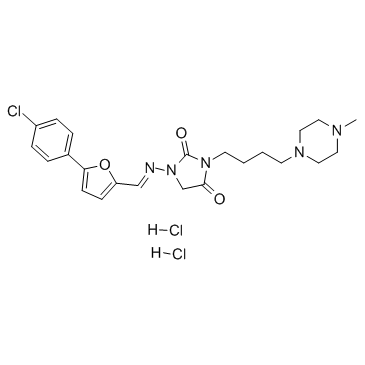The effect of high extracellular potassium on IKr inhibition by anti-arrhythmic agents.
Congrong Lin, Xiaogang Ke, Ivana Cvetanovic, Vasant Ranade, John Somberg
Index: Cardiology 108(1) , 18-27, (2007)
Full Text: HTML
Abstract
Hyperkalemia is a potentially life-threatening disorder frequently occurring in hospitalized patients. The ischemic myocardium releases potassium into the extracellular space which can cause regional hyperkalemia. These changes may modify the effects of anti-arrhythmic drugs acting on the rapid component of the delayed rectifier potassium current (IKr). We evaluated the influence of increased extracellular potassium concentration [K(+)](e) on IKr inhibition by amiodarone, azimilide, dofetilide, quinidine and sotalol.Experiments were performed at room temperature. IKr current was studied by using HERG gene expressed in Xenopus oocytes as a model of cardiac IKr. Two-electrode voltage clamp technique was employed. The recording bath solutions contained either 5 or 10 mmol/l KCl. Amiodarone, azimilide, dofetilide, quinidine and sotalol all produced a dose-dependent inhibition of HERG current. At 5 mmol/l [K(+)](e), the IC(50) was 37.0 +/- 12.5 microM for amiodarone, 5.8 +/- 0.4 microM for azimilide, 1.5 +/- 0. 2 microM for dofetilide, 9.1 +/- 1.5 microM for quinidine, and 5.1 +/- 0.8 mM for sotalol. Raising the extracellular potassium to 10 mmol/l, HERG block by azimilide, dofetilide, quinidine and sotalol was significantly decreased, while the block by amiodarone was unchanged. The differences in the percentage current block produced by 3 microM drugs at 5 and 10 mmol/l [K(+)](e) were: -0.9% for amiodarone, 13.8% for quinidine, 20.5% for azimilide, and 16.2% for dofetilide. The differences in percentage block between 5 and 10 mmol/l [K(+)](e) by sotalol 10 and 30 mM were 7.1 and 5.6%. At 10 mmol/l [K(+)](e), the IC(50) was increased for azimilide, dofetilide, quinidine and sotalol but not for amiodarone; the IC(50) was 24.7 +/- 7.4 microM for amiodarone, 29.3 +/- 3.9 microM for azimilide, 2.7 +/- 0.2 microM for dofetilide, 27.6 +/- 4.0 microM for quinidine, and 7.2 +/- 1.7 mM for sotalol.Inhibition of IKr by azimilide, quinidine, dofetilide and sotalol was diminished by increasing [K(+)](e), while the inhibition by amiodarone was unchanged at normal and high [K(+)](e). The differential effects of azimilide, dofetilide, quinidine and sotalol at normal and high [K(+)](e) could be pro-arrhythmic by favoring re-entry arrhythmias. These results further support the unique electrophysiological effect of amiodarone.Copyright 2007 S. Karger AG, Basel.
Related Compounds
| Structure | Name/CAS No. | Molecular Formula | Articles |
|---|---|---|---|
 |
Azimilide (Dihydrochloride)
CAS:149888-94-8 |
C23H30Cl3N5O3 |
|
Azimilide dihydrochloride: a new class III anti-arrhythmic a...
2000-11-01 [Expert Opin. Investig. Drugs 9(11) , 2705-15, (2000)] |
|
Electrophysiological and antiarrhythmic effects of the novel...
2006-07-01 [Europace 8(7) , 549-57, (2006)] |
|
Azimilide for the treatment of atrial fibrillation, atrial f...
2008-02-01 [J. Cardiovasc. Electrophysiol. 19(2) , 172-7, (2008)] |
|
Role of drug therapy for sustained ventricular tachyarrhythm...
2008-08-01 [Cardiol. Clin. 26(3) , 405-18, vi, (2008)] |
|
Effects of azimilide on the muscarinic acetylcholine recepto...
2007-11-01 [J. Pharmacol. Sci. 105(3) , 229-39, (2007)] |